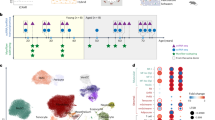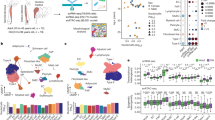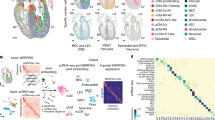Abstract
Fusion of myoblasts is essential for the formation of multi-nucleated muscle fibres. However, the identity of muscle-specific proteins that directly govern this fusion process in mammals has remained elusive. Here we identify a muscle-specific membrane protein, named myomaker, that controls myoblast fusion. Myomaker is expressed on the cell surface of myoblasts during fusion and is downregulated thereafter. Overexpression of myomaker in myoblasts markedly enhances fusion, and genetic disruption of myomaker in mice causes perinatal death due to an absence of multi-nucleated muscle fibres. Remarkably, forced expression of myomaker in fibroblasts promotes fusion with myoblasts, demonstrating the direct participation of this protein in the fusion process. Pharmacological perturbation of the actin cytoskeleton abolishes the activity of myomaker, consistent with previous studies implicating actin dynamics in myoblast fusion. These findings reveal a long-sought myogenic fusion protein that controls mammalian myoblast fusion and provide new insights into the molecular underpinnings of muscle formation.
This is a preview of subscription content, access via your institution
Access options
Subscribe to this journal
Receive 51 print issues and online access
$199.00 per year
only $3.90 per issue
Buy this article
- Purchase on Springer Link
- Instant access to full article PDF
Prices may be subject to local taxes which are calculated during checkout





Similar content being viewed by others
References
Chen, E. H. & Olson, E. N. Unveiling the mechanisms of cell-cell fusion. Science 308, 369–373 (2005)
Bentzinger, C. F., Wang, Y. X. & Rudnicki, M. A. Building muscle: molecular regulation of myogenesis. Cold Spring Harb. Perspect. Biol. 4, a008342 (2012)
Berkes, C. A. & Tapscott, S. J. MyoD and the transcriptional control of myogenesis. Semin. Cell Dev. Biol. 16, 585–595 (2005)
Buckingham, M. Myogenic progenitor cells and skeletal myogenesis in vertebrates. Curr. Opin. Genet. Dev. 16, 525–532 (2006)
Kang, J. S. & Krauss, R. S. Muscle stem cells in developmental and regenerative myogenesis. Curr. Opin. Clin. Nutr. Metab. Care 13, 243–248 (2010)
Abmayr, S. M. & Pavlath, G. K. Myoblast fusion: lessons from flies and mice. Development 139, 641–656 (2012)
Rochlin, K., Yu, S., Roy, S. & Baylies, M. K. Myoblast fusion: when it takes more to make one. Dev. Biol. 341, 66–83 (2010)
Charrasse, S. et al. M-cadherin activates Rac1 GTPase through the Rho-GEF trio during myoblast fusion. Mol. Biol. Cell 18, 1734–1743 (2007)
Charrasse, S., Meriane, M., Comunale, F., Blangy, A. & Gauthier-Rouviere, C. N-cadherin-dependent cell-cell contact regulates Rho GTPases and beta-catenin localization in mouse C2C12 myoblasts. J. Cell Biol. 158, 953–965 (2002)
Schwander, M. et al. β1 integrins regulate myoblast fusion and sarcomere assembly. Dev. Cell 4, 673–685 (2003)
Griffin, C. A., Kafadar, K. A. & Pavlath, G. K. MOR23 promotes muscle regeneration and regulates cell adhesion and migration. Dev. Cell 17, 649–661 (2009)
Yagami-Hiromasa, T. et al. A metalloprotease-disintegrin participating in myoblast fusion. Nature 377, 652–656 (1995)
Davis, R. L., Weintraub, H. & Lassar, A. B. Expression of a single transfected cDNA converts fibroblasts to myoblasts. Cell 51, 987–1000 (1987)
Hasty, P. et al. Muscle deficiency and neonatal death in mice with a targeted mutation in the myogenin gene. Nature 364, 501–506 (1993)
Vasyutina, E., Martarelli, B., Brakebusch, C., Wende, H. & Birchmeier, C. The small G-proteins Rac1 and Cdc42 are essential for myoblast fusion in the mouse. Proc. Natl Acad. Sci. USA 106, 8935–8940 (2009)
Gruenbaum-Cohen, Y. et al. The actin regulator N-WASp is required for muscle-cell fusion in mice. Proc. Natl Acad. Sci. USA 109, 11211–11216 (2012)
Wright, L. P. & Philips, M. R. Thematic review series: lipid posttranslational modifications. CAAX modification and membrane targeting of Ras. J. Lipid Res. 47, 883–891 (2006)
Pei, J., Millay, D. P., Olson, E. N. & Grishin, N. V. CREST–a large and diverse superfamily of putative transmembrane hydrolases. Biol. Direct 6, 37 (2011)
Corcoran, J. A. & Duncan, R. Reptilian reovirus utilizes a small type III protein with an external myristylated amino terminus to mediate cell-cell fusion. J. Virol. 78, 4342–4351 (2004)
Chen, E. H. & Olson, E. N. Antisocial, an intracellular adaptor protein, is required for myoblast fusion in Drosophila. Dev. Cell 1, 705–715 (2001)
Chen, E. H., Pryce, B. A., Tzeng, J. A., Gonzalez, G. A. & Olson, E. N. Control of myoblast fusion by a guanine nucleotide exchange factor, loner, and its effector ARF6. Cell 114, 751–762 (2003)
Nowak, S. J., Nahirney, P. C., Hadjantonakis, A. K. & Baylies, M. K. Nap1-mediated actin remodeling is essential for mammalian myoblast fusion. J. Cell Sci. 122, 3282–3293 (2009)
Laurin, M. et al. The atypical Rac activator Dock180 (Dock1) regulates myoblast fusion in vivo. Proc. Natl Acad. Sci. USA 105, 15446–15451 (2008)
Powell, G. T. & Wright, G. J. Jamb and jamc are essential for vertebrate myocyte fusion. PLoS Biol. 9, e1001216 (2011)
Oren-Suissa, M. & Podbilewicz, B. Cell fusion during development. Trends Cell Biol. 17, 537–546 (2007)
Wilson, N. F. & Snell, W. J. Microvilli and cell-cell fusion during fertilization. Trends Cell Biol. 8, 93–96 (1998)
Shilagardi, K. et al. Actin-propelled invasive membrane protrusions promote fusogenic protein engagement during cell-cell fusion. Science 340, 359–363 (2013)
Skarnes, W. C. et al. A conditional knockout resource for the genome-wide study of mouse gene function. Nature 474, 337–342 (2011)
Hargrave, M. & Koopman, P. In situ hybridization of whole-mount embryos. Methods Mol. Biol. 123, 279–289 (2000)
Kitamura, T. et al. Efficient screening of retroviral cDNA expression libraries. Proc. Natl Acad. Sci. USA 92, 9146–9150 (1995)
Song, K. et al. Heart repair by reprogramming non-myocytes with cardiac transcription factors. Nature 485, 599–604 (2012)
Shelton, J. M., Lee, M. H., Richardson, J. A. & Patel, S. B. Microsomal triglyceride transfer protein expression during mouse development. J. Lipid Res. 41, 532–537 (2000)
Acknowledgements
We thank J. Cabrera for graphics, the Transgenic Technology Center at University of Texas Southwestern Medical Center for embryonic stem cell injections, J.A. Richardson for histology and the University of Texas Southwestern Live Cell Imaging Facility (K. Luby-Phelps and A. Budge) for microscopy and live cell-imaging assistance. We thank D. Rosenbaum, W. Snell, S. Schmid, J. Seemann and members of the Olson laboratory for scientific discussions. D.P.M. was financed by a National Institutes of Health National Research Service Award Fellowship (F32AR05948403). This work was supported by grants from the National Institutes of Health (HL-077439, HL-111665, HL093039 and U01-HL-100401) and the Robert A. Welch Foundation (grant 1-0025) (to E.N.O.).
Author information
Authors and Affiliations
Contributions
D.P.M. and E.N.O. conceived the project and designed the experiments. D.P.M., J.R.O., L.B.S., S.B. and J.M.S. performed experiments. D.P.M. and R.B.-D. wrote the animal protocol. D.P.M. and E.N.O. analysed the data and prepared the manuscript.
Corresponding author
Ethics declarations
Competing interests
The authors declare no competing financial interests.
Supplementary information
Supplementary Figures
This file contains Supplementary Figures 1-8. (PDF 9769 kb)
Time-lapse microscopy of C2C12 myoblasts infected with GFP and Myomaker
C2C12 cells were infected with GFP and Myomaker retrovirus and induced to differentiate. This video depicts a myoblast fusing to a myoblast (arrowhead) and fusion of two myotubes (arrows). Myomaker not only increases myoblast-myotube fusion, but also myotube-myotube fusion. The video represents 32 hours of culture, beginning 48 hours after differentiation. Frames are 15 minutes apart and video speed is 3 frames/second. (MOV 11306 kb)
Myomaker-infected fibroblasts fusing to muscle cells
10T½ fibroblasts were infected with GFP and Myomaker. C2C12 myoblasts were infected with dsRed and then mixed with the GFP+Myomaker-infected fibroblasts and induced to differentiate. Red/Green chimeric myotubes, generated from the fusion of myoblasts and fibroblasts, can be visualized fusing with a C2C12 cell (red arrow) and fibroblasts (green arrows). The video represents 40 hours of culture, beginning 48 hours after differentiation. Frames are 15 minutes apart and video speed is 3 frames/second. (MOV 27854 kb)
Rights and permissions
About this article
Cite this article
Millay, D., O’Rourke, J., Sutherland, L. et al. Myomaker is a membrane activator of myoblast fusion and muscle formation. Nature 499, 301–305 (2013). https://doi.org/10.1038/nature12343
Received:
Accepted:
Published:
Issue Date:
DOI: https://doi.org/10.1038/nature12343
This article is cited by
-
Integrating miRNA and full-length transcriptome profiling to elucidate the mechanism of muscle growth in Muscovy ducks reveals key roles for miR-301a-3p/ANKRD1
BMC Genomics (2024)
-
Towards Understanding the Role of Microstructured Edible Scaffolds for Cultured Meat Production
Food and Bioprocess Technology (2024)
-
Expression of Myomaker and Myomerger in myofibers causes muscle pathology
Skeletal Muscle (2023)
-
Intrinsic signalling factors associated with cancer cell-cell fusion
Cell Communication and Signaling (2023)
-
Regulation of myogenesis and adipogenesis by the electromagnetic perceptive gene
Scientific Reports (2023)
Comments
By submitting a comment you agree to abide by our Terms and Community Guidelines. If you find something abusive or that does not comply with our terms or guidelines please flag it as inappropriate.



